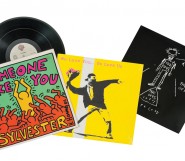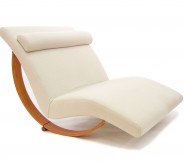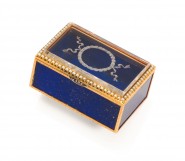Lot #6 - Rosalie Gascoigne
-
Auction House:Deutscher and Hackett
-
Sale Name:Important Australian + International Fine Art
-
Sale Date:01 Dec 2022 ~ 7pm (AEDT)
-
Lot #:6
-
Lot Description:Rosalie Gascoigne
(1917 - 1999)
Beaten Track, 1992
sawn wood soft drink crates on plywood
122.0 x 110.0 cm
signed, dated and inscribed with title verso: Rosalie Gascoigne / 1992 / BEATEN TRACK; signed and dated verso [inverted]: Rosalie Gascoigne / 1992 -
Provenance:Roslyn Oxley9 Gallery, Sydney (label attached verso); Private collection, Sydney, acquired from the above in 1992; Christie's, Sydney, 24 May 2005, lot 38; Private collection, London
-
Exhibited:Rosalie Gascoigne, Roslyn Oxley9 Gallery, Sydney, 15 April – 2 May 1992, cat. 10; Toi Toi Toi, Three Generations of Artists from New Zealand, Museum Fridericianum, Kassel, Germany, 23 January – 5 April 1999; Auckland Art Gallery Toi o Tāmaki, Auckland, New Zealand, 22 May – 4 July 1999, cat. 67
-
References:Toi Toi Toi, Three Generations of Artists from New Zealand, Auckland Art Gallery Toi o Tāmaki, Auckland, 1998, cat. 67, p. 64 (illus.); McDonald, V., Rosalie Gascoigne, Regaro Pty Ltd, Sydney, 1998, pl. 31, pp. 69 (illus.), 114; Gascoigne, M., Rosalie Gascoigne. A Catalogue Raisonné, ANU Press, Canberra, 2019, cat. 428, pp. 84, 253 (illus.), 413
-
Notes:"Second hand materials aren't deliberate; they have sun and wind on them. Simple things. From simplicity you get profundity."1 With her training in the formal discipline of Ikebana complementing her intuitive understanding of the nature of materials, her deep attachment to her environment and later interest in modern art, Rosalie Gascoigne remains one of Australia's most unique and beloved contemporary artists. Bespeaking a staunchness and scrupulous eye, her works are artful and refined, yet always betray a tangible connection to the outside world, powerfully evoking remembered feelings or memories in relationship to the landscape – they are 'instances of emotion recollected in tranquillity' to quote a phrase of Wordsworth's which was so dear to her. Notwithstanding her formidable reputation today as one of the most significant artists of the twentieth century however, remarkably Gascoigne's career as a professional artist did not begin until the age of 57 when she exhibited four assemblages in a group show in Sydney. Immediately attracting enthusiastic praise from collectors and critics alike, she was soon offered her maiden solo exhibition at a public institution in 19782, and in 1982, was selected as the inaugural female artist to represent Australia at the Venice Biennale where she unveiled, among other works, Scrub Country, 1981 – the first of her now-famous creations constructed from weathered soft-drink crates. A magnificent example of these shimmering 'black-on-gold' assemblages fashioned from hand sawn Schweppes wooden crates, significantly Beaten Track, 1992 was first exhibited in the artist's seminal solo exhibition held at Roslyn Oxley Gallery, Sydney in April – May of that year. Heralding Gascoigne's transition from busy, brightly-coloured works employing several materials towards calmer, more meditative pieces in natural wood, the show remains widely recognised as one of the most ground-breaking of her unconventional career – attested by the fact that at least nine of the works exhibited have subsequently entered prestigious collections internationally including the Metropolitan Museum of Art, New York; the Art Gallery of New South Wales; the National Gallery of Victoria; and the Macquarie Bank Collection. Bearing striking stylistic affinities with Gascoigne's celebrated four-panel masterpiece, Monaro, 1989 in the collection of the Art Gallery of Western Australia, Beaten Track similarly draws its inspiration from the artist's immediate surroundings – namely the spacious grazing lands of the Monaro region on the outskirts of Canberra with their seasonal variation, diverse topography and myriad traces of history and use. Yet despite their specific impetus, such compositions notably do not depict or symbolise the local landscape; rather the deft arrangement and tonal variation of the wooden slivers eloquently conveys a larger, more universal sense of place that is, paradoxically, 'both nowhere and everywhere at once.'3 Eschewing the use of iconography to present the viewer with openings to a number of worlds – and not simply the land as a conventional visual essay where form and subject correspond – thus Gascoigne creates exquisite distillations of the landscape that resonate with a virtually endless allusive power. With their rhythmic pattern composed of letters – 'text transformed into texture' – such assemblages have, not surprisingly, been described as 'concrete stammering poems'4, a perceptive analogy given the artist's predilection for poetry from Shakespeare to Plath. Nevertheless, Gascoigne reiterates that the flickering word fragments, though carefully arranged, are not intended to be read literally: 'Placement of letters is important, but it's not a matter of reading the text – it's a matter of getting a visually pleasing result.'5 Similarly, her titles are also not prescriptive but rather, 'leave room for the viewer'6, imbued with various levels of meaning to be deciphered according to the nature of one's experiences. Accordingly, while 'Beaten Track' may seem a fitting description for this unruly path of black lettering laid out against the promise of 'a yellow brick road', what also springs to mind is the expression 'off the beaten track' – a concept whose appropriateness becomes all the more apparent the longer one gazes at the work. For that is precisely what Beaten Track encapsulates – redolent with poetic possibility, it is a catalyst for ideas not yet encountered, an invitation to venture to places not yet explored. As John McDonald elucidates, Gascoigne's art '...awakens associations that lie beneath the surface of consciousness, inviting a higher degree of sensitivity and attentiveness to the world around us...'7 Indeed, it is this higher awareness, the ability to recognise beauty in the most humble and unprepossessing of materials that Gascoigne demands of her audience. For, as the eye moves through this skilful arrangement searching for information within the weathered components, and the mind attempts to place different rules of perspective or build upon the suggestion of the marks, 'in time we recognise that the only solution is to stop trying to navigate through the forest of symbols and to enjoy the beauty of the trees.'8 1. The artist cited in Edwards, D., Rosalie Gascoigne: Material as Landscape, Trustees of the Art Gallery of New South Wales, Sydney, 1998, p. 11; 2. Survey 2: Rosalie Gascoigne, National Gallery of Victoria, Melbourne, 29 April - 4 June 1978; 3. Cameron, D., What is Contemporary Art?, exhibition catalogue, Rooseum, Malmo, Sweden, 1989, p. 18; 4. Hilty, G., Art Monthly, United Kingdom, September 1997, p. 46; 5. The artist cited in MacDonald, V., Rosalie Gascoigne, Regaro, Sydney, 1998, p. 35; 6. The artist, cited ibid; 7. McDonald, J., 'Introduction', in MacDonald, op. cit., p. 7; 8. Ibid. VERONICA ANGELATOS
-
Estimate:A$400,000 - 600,000
-
Realised Price:
-
Category:Art
This Sale has been held and this item is no longer available. Details are provided for information purposes only.










